-
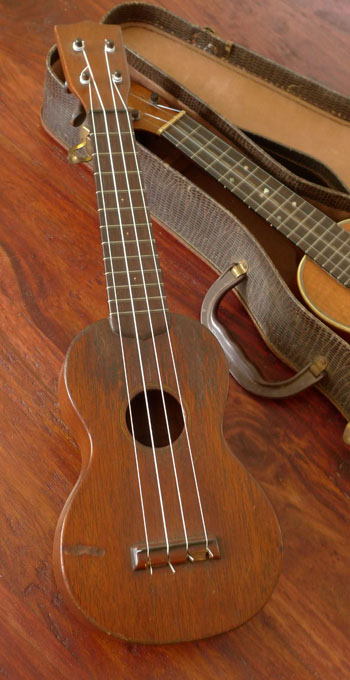 A pre-decal Uke from Martin. Style 0, with no body binding. Well worn, but 100% crack free.
A pre-decal Uke from Martin. Style 0, with no body binding. Well worn, but 100% crack free. -
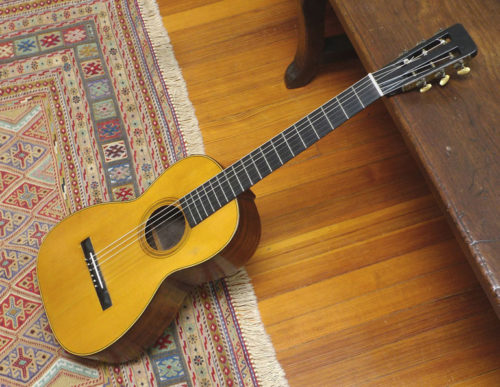 This guitar is the last known guitar in existence, made by Louis Schmidt, the famous contemporary and one-time colleague to the founder of Martin Guitars, the original C.F. Martin. As such, it is a rare example of early American guitar making. And it’s signed by the maker, on the underside of the Adirondack top: Louis Schmidt Wakefield Westchester Cy NY July 9th 1859 U.S. Louis Schmidt worked side by side with CF Martin in the early years. Perhaps the most common misconception about early American guitar history is that C. F. Martin spent his first years in America earning a living as a solitary luthier in his New York workshop. Pay ledgers reveal that as early as 1834 he was paying luthiers to help him make his guitars. Two of these men, Heinrich Schatz and Louis Schmidt, left Martin's employ to make guitars on their own, and each succeeded as top builders. This instrument:
This guitar is the last known guitar in existence, made by Louis Schmidt, the famous contemporary and one-time colleague to the founder of Martin Guitars, the original C.F. Martin. As such, it is a rare example of early American guitar making. And it’s signed by the maker, on the underside of the Adirondack top: Louis Schmidt Wakefield Westchester Cy NY July 9th 1859 U.S. Louis Schmidt worked side by side with CF Martin in the early years. Perhaps the most common misconception about early American guitar history is that C. F. Martin spent his first years in America earning a living as a solitary luthier in his New York workshop. Pay ledgers reveal that as early as 1834 he was paying luthiers to help him make his guitars. Two of these men, Heinrich Schatz and Louis Schmidt, left Martin's employ to make guitars on their own, and each succeeded as top builders. This instrument:- Similar features to circa 1860 Martin 17 style... but different purfling, binding, and slightly different body shape
- All original finish
- Brazilian rosewood back and sides (solid); Adirondack top
- In its original coffin case
- 11 3/8 inches wide at lower bout (a bit larger than a Martin 2 1/2)
- Body: 3 7/8 inches deep
- Original mahogany bridge plate (goes almost all the way across the width of the top, slotted under all the braces)
- Fan bracing pattern
- Plays beautifully. Good bass tone. Action is perfect.
- Ebony Bridge has been off at some point, and reglued on. With a lack of similar guitars on the market, it’s not known if this 19th century bridge on the instrument is the original bridge.
- One repaired crack on top, from bridge to bottom binding; One repaired crack on back. One small crack on top, either top edge of soundhole.
- Original Jerome tuners, reverse gear, working perfectly
- Maple and rosewood purfling/binding on top (no binding on back)
-
 Nothing sounds like a 30’s Gibson L-00. No longer a sleeper on the vintage guitar market–they are sought after by working musicians the world over¬–they are still under-rated on the collector market. These mid-size Gibsons are incredibly resonant. There is nothing like them, from Gibson, and the mid-size Adirondack spruce over mahogany Martins from the mid to late 30’s command more than twice the price. This L-00 from 1938 has the best tone of any of the 30’s L-00’s we’ve seen. You won’t believe its presence. Acquired by us from the family of the original owner in Austin, Texas, this guitar is a great example of the era when Gibson still had a production jump on Martin, and even its lower cost guitars were winning the marketing war at the trailing end of the depression. This L-00 had a re-spray of its burst in the early 60’s, so while not the original finish, it’s got the right look and feel of the 30’s, and plenty of mileage to make it more than convincing. The top and sides are completely crack-free, and there are only two small cracks on the back. One is not through the wood, and the other was expertly addressed by Tony Nobles with a small cleat. Tony also made a new perfect reproduction Brazilian Rosewood bridge. The bridge plate is original and in great condition. Original firestripe pickguard. Original nut. The non-original tuners on the instrument when we acquired it were replaced by us with klusons from the period. Tony also installed new T-frets. While we tend to specialize in vintage Martins, this one might change my mind.
Nothing sounds like a 30’s Gibson L-00. No longer a sleeper on the vintage guitar market–they are sought after by working musicians the world over¬–they are still under-rated on the collector market. These mid-size Gibsons are incredibly resonant. There is nothing like them, from Gibson, and the mid-size Adirondack spruce over mahogany Martins from the mid to late 30’s command more than twice the price. This L-00 from 1938 has the best tone of any of the 30’s L-00’s we’ve seen. You won’t believe its presence. Acquired by us from the family of the original owner in Austin, Texas, this guitar is a great example of the era when Gibson still had a production jump on Martin, and even its lower cost guitars were winning the marketing war at the trailing end of the depression. This L-00 had a re-spray of its burst in the early 60’s, so while not the original finish, it’s got the right look and feel of the 30’s, and plenty of mileage to make it more than convincing. The top and sides are completely crack-free, and there are only two small cracks on the back. One is not through the wood, and the other was expertly addressed by Tony Nobles with a small cleat. Tony also made a new perfect reproduction Brazilian Rosewood bridge. The bridge plate is original and in great condition. Original firestripe pickguard. Original nut. The non-original tuners on the instrument when we acquired it were replaced by us with klusons from the period. Tony also installed new T-frets. While we tend to specialize in vintage Martins, this one might change my mind. -
Out of stock
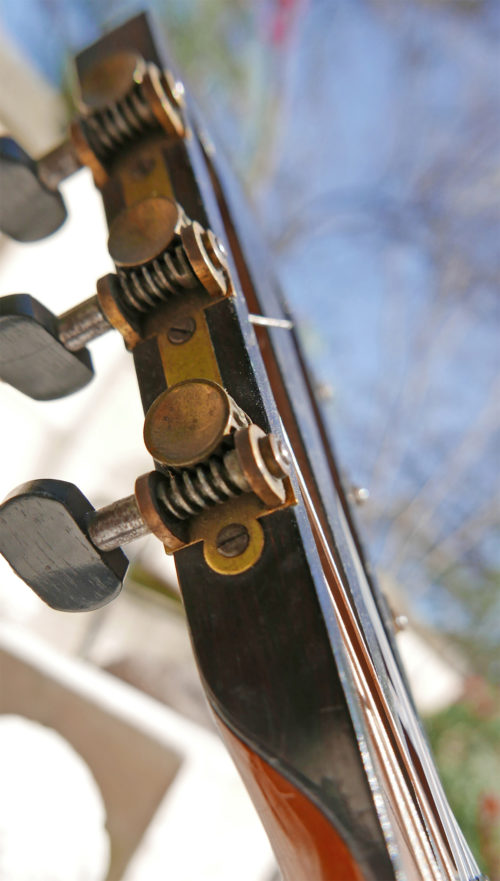 Circa 1860, style 3 guitar built by renowned luthier, James Ashborn of Wolcottville, CT, for William Hall & Son music store. Brazilian rosewood back and sides; Adirondack top; double maple binding (on both back, and front); original coffin case. This guitar is is 100% original, including all original finish, and down to original ebony nut, and original bridge (and saddle) that has never been off the guitar. And it comes in its original wood coffin case, as it left the factory around 1860. This James Ashborn style 3 is rare, and unique because it has brazilian veneer on the neck (not the fretboard which is ebony, but the back of neck), original to the guitar. And, that is very rare for any style/number Ashborn. Also unique to Ashborn’s style 3: his trademark hand-made tuners, have ebony buttons (not rosewood buttons as on his style 1, and 2) And this is a superb sounding Ashborn, unrivaled in tone by any 1850’s/1860’s American guitar we’ve seen and played, including any Martin from that era. Ashborn varied a few details on his guitars (styles 1,2,3, 5), but he did not vary the size of the guitars. He made them all the same body and neck size (unlike Martin for example). They are all the same size. And almost all had spruce/Brazilian veneer on back and sides. As this does. • Nut width is 1 7/8 inches • Width at lower bout: 11 3/8 inches • Scale Length: 24 inches • the action is 4/32 inch on both sides, at 12th string – normal action for this kind of guitar • There are repaired cracks on top, and back of guitar. All professionally repaired. James Ashborn was born in England circa 1816 and came to New England in the late 1830s. Ashborn had his shop in Torrington, but soon after start-up, he began selling guitars to the New York distributor William Hall & Son, whose name appears inside the instruments. From Vintage Guitar magazine: “Ashborn’s design for the guitar was quite innovative for the early 19th century. Instead of making guitars fashioned after the typical parlor-style guitars, he made them in the Spanish style, by taking interior bracing cues from the Spanish while retaining the body of the English guitars. This included a fan brace pattern rather than the more common ladder pattern Ashborn guitars have a very complex dovetail V joint for attaching the head to the neck. The headstock was cut in roughly five steps, using some kind of tracing router, as suggested by the chatter marks on the inside ears of the pegbox. In addition to the complex head design, Ashborn made his own tuning machines in-house. They’re made of brass, very much like contemporary machines, with worm gears, cog gears, and rollers. … Ashborn’s shop was extremely advanced for its time, having a great deal of know-how and technology. Ashborn understood the need to have the technology as well as the skill, but more importantly he discovered a new way of making high-quality instruments that were affordable. He was able to create a factory environment where workers did what they were good at and, with practice, became very fast and consistent. With a new level of consistency in mass production, he created the path followed by other companies such as Martin, Gibson, and Taylor. Using designs ahead of his time, he was able to bring the sound and change to people who otherwise never would have been able to acquire an instrument of this quality.” .... No longer available....
Circa 1860, style 3 guitar built by renowned luthier, James Ashborn of Wolcottville, CT, for William Hall & Son music store. Brazilian rosewood back and sides; Adirondack top; double maple binding (on both back, and front); original coffin case. This guitar is is 100% original, including all original finish, and down to original ebony nut, and original bridge (and saddle) that has never been off the guitar. And it comes in its original wood coffin case, as it left the factory around 1860. This James Ashborn style 3 is rare, and unique because it has brazilian veneer on the neck (not the fretboard which is ebony, but the back of neck), original to the guitar. And, that is very rare for any style/number Ashborn. Also unique to Ashborn’s style 3: his trademark hand-made tuners, have ebony buttons (not rosewood buttons as on his style 1, and 2) And this is a superb sounding Ashborn, unrivaled in tone by any 1850’s/1860’s American guitar we’ve seen and played, including any Martin from that era. Ashborn varied a few details on his guitars (styles 1,2,3, 5), but he did not vary the size of the guitars. He made them all the same body and neck size (unlike Martin for example). They are all the same size. And almost all had spruce/Brazilian veneer on back and sides. As this does. • Nut width is 1 7/8 inches • Width at lower bout: 11 3/8 inches • Scale Length: 24 inches • the action is 4/32 inch on both sides, at 12th string – normal action for this kind of guitar • There are repaired cracks on top, and back of guitar. All professionally repaired. James Ashborn was born in England circa 1816 and came to New England in the late 1830s. Ashborn had his shop in Torrington, but soon after start-up, he began selling guitars to the New York distributor William Hall & Son, whose name appears inside the instruments. From Vintage Guitar magazine: “Ashborn’s design for the guitar was quite innovative for the early 19th century. Instead of making guitars fashioned after the typical parlor-style guitars, he made them in the Spanish style, by taking interior bracing cues from the Spanish while retaining the body of the English guitars. This included a fan brace pattern rather than the more common ladder pattern Ashborn guitars have a very complex dovetail V joint for attaching the head to the neck. The headstock was cut in roughly five steps, using some kind of tracing router, as suggested by the chatter marks on the inside ears of the pegbox. In addition to the complex head design, Ashborn made his own tuning machines in-house. They’re made of brass, very much like contemporary machines, with worm gears, cog gears, and rollers. … Ashborn’s shop was extremely advanced for its time, having a great deal of know-how and technology. Ashborn understood the need to have the technology as well as the skill, but more importantly he discovered a new way of making high-quality instruments that were affordable. He was able to create a factory environment where workers did what they were good at and, with practice, became very fast and consistent. With a new level of consistency in mass production, he created the path followed by other companies such as Martin, Gibson, and Taylor. Using designs ahead of his time, he was able to bring the sound and change to people who otherwise never would have been able to acquire an instrument of this quality.” .... No longer available.... -
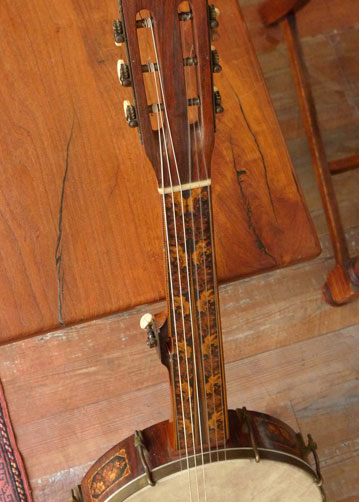 Read the full description below. If you're interested in this guitar, please call 512.922.8596 or contact us here.
Read the full description below. If you're interested in this guitar, please call 512.922.8596 or contact us here. -
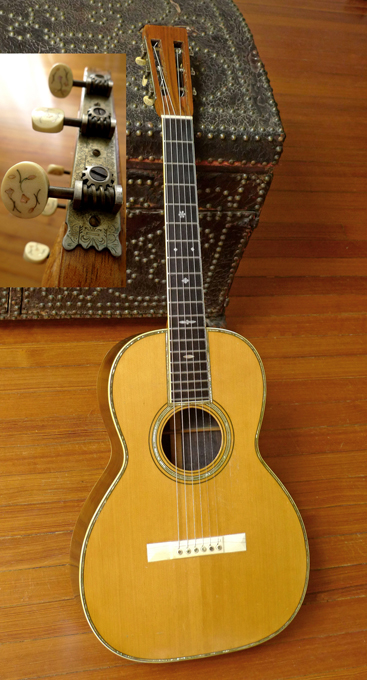 Exquisite, and a joy to play (… the top level, largest guitar that Martin made at the turn of the 20th century– with tone that shows off what Frank Henry Martin was proud of when he personally signed the inside of this instrument in April, 1903…)
Exquisite, and a joy to play (… the top level, largest guitar that Martin made at the turn of the 20th century– with tone that shows off what Frank Henry Martin was proud of when he personally signed the inside of this instrument in April, 1903…) -
 This fine Brazilian Rosewood 12-fret Martin is a joy to play, and it’s properly set up for steel strings. The grandson of C. F. Martin, Sr., Frank Henry Martin oversaw the Martin business from 1880 until well into twentieth century, and was responsible for the creation of the Style 0. I’m sure he loved this guitar–he personally signed the instrument, in cursive, under the top: “# 10082 Oct. 17th, 1905 F.H.M.” This 0-21 combines the exquisite tone of a 100 year old Martin, with some wonderful restoration. Guitar was refinished, probably decades ago, and it is a beautiful, French polish finish that has all the earmarks of an original finish. You can see the pores and saw marks in the Brazilian rosewood. No heavy-handed finish here, it’s a natural finish that lets the grain and color of the wood come through. And the tone, too, that sweet tone you can only get from Brazilian this old. The ebony pyramid bridge is a replacement, and features a compensated saddle, so intonation is dead on. (The bridge plate is the original small maple plate, in perfect condition.) Original tuners. Crack-free top and sides. There is only one very small crack, on the back, about 3 inches long, professionally repaired. The neck was set recently by Tony Nobles, and the original bar frets dressed. It plays, and sounds, like a late 20’s 12-fret Brazilian rosewood Martin.
This fine Brazilian Rosewood 12-fret Martin is a joy to play, and it’s properly set up for steel strings. The grandson of C. F. Martin, Sr., Frank Henry Martin oversaw the Martin business from 1880 until well into twentieth century, and was responsible for the creation of the Style 0. I’m sure he loved this guitar–he personally signed the instrument, in cursive, under the top: “# 10082 Oct. 17th, 1905 F.H.M.” This 0-21 combines the exquisite tone of a 100 year old Martin, with some wonderful restoration. Guitar was refinished, probably decades ago, and it is a beautiful, French polish finish that has all the earmarks of an original finish. You can see the pores and saw marks in the Brazilian rosewood. No heavy-handed finish here, it’s a natural finish that lets the grain and color of the wood come through. And the tone, too, that sweet tone you can only get from Brazilian this old. The ebony pyramid bridge is a replacement, and features a compensated saddle, so intonation is dead on. (The bridge plate is the original small maple plate, in perfect condition.) Original tuners. Crack-free top and sides. There is only one very small crack, on the back, about 3 inches long, professionally repaired. The neck was set recently by Tony Nobles, and the original bar frets dressed. It plays, and sounds, like a late 20’s 12-fret Brazilian rosewood Martin. -
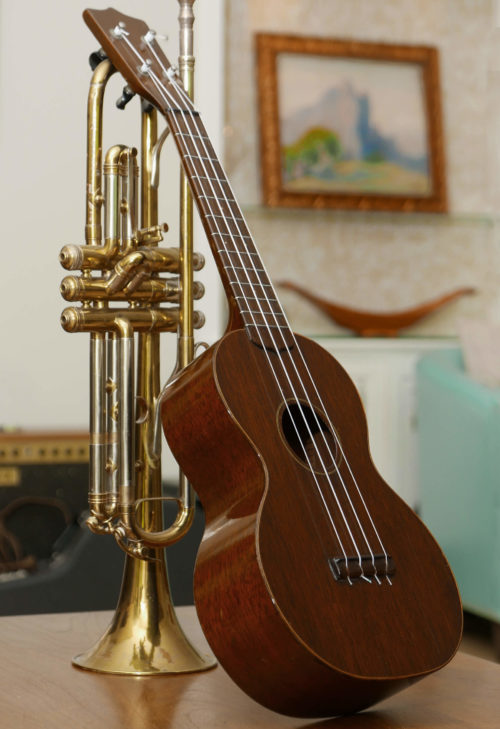 A beautiful example of one of the rarest prewar Martin ukuleles. This is a prewar Martin C-1. (All Concert Model ukuleles from Martin– with the exception of few special orders– were style 1). Officially called the Concert model ukulele, it’s larger than the many soprano size ukes. It’s very rare to find a prewar C-1 on the market– and much rarer still to find a pre-1933. This instrument was made between 1925 and 1933– because of the Martin stamp on the back of the headstock and the lack of the (post-1933) Martin decal on the front of the headstock. This is currently the only Martin C-1 from the late 1920’s on the market. And the tone and playability are perfect. Louder, and more bell like tone than a Martin Style 1 soprano uke. Martin concert ukuleles are the same body size as taropatch (1918-1932) but with four strings only. While the taropatch had been offered with four strings since its introduction, the new concert model was different in that it had a narrower neck and a standard soprano-size bridge. It was added to the standard catalog that year and by 1927 it was outselling all taropatch models combined. Concerts ukuleles are tuned the same as the sopranos but because of the larger body have a deeper and richer sound, and a slightly longer, easier to play scale length of 14 3/4". The Concert Ukulele from Martin–while rare to find a prewar example– is considered the ideal size for players– larger than the tiny soprano but not too big like the Martin Tenor uke. This one has a rich, beautiful tone, and it’s almost unplayed condition. The action is perfect. There is one small crack on top–but it’s essentially “cleated” by the orignal bridde plate and does not need addressing, and a smaller finish crack that does not go through to the inside). The braces and all else inside: pristine. And it even comes in its original canvas case. Like most Martin ukes, the mahogany bridge had some wear on the string slots. So we created a new, replacement, 100% historically correct replacement bridge. Original patent tuners Original ebony nut Brazilian rosewood fretboard Style 1: all mahogany, with brazilian binding on top Total length: 23 ¼ inches Body length: 11 inches Body width upper bout: 5 ¾ inches Body width lower bout: 7 5/8 inches Scale length: 14 ¾ inches Price: with original case. $2150.
A beautiful example of one of the rarest prewar Martin ukuleles. This is a prewar Martin C-1. (All Concert Model ukuleles from Martin– with the exception of few special orders– were style 1). Officially called the Concert model ukulele, it’s larger than the many soprano size ukes. It’s very rare to find a prewar C-1 on the market– and much rarer still to find a pre-1933. This instrument was made between 1925 and 1933– because of the Martin stamp on the back of the headstock and the lack of the (post-1933) Martin decal on the front of the headstock. This is currently the only Martin C-1 from the late 1920’s on the market. And the tone and playability are perfect. Louder, and more bell like tone than a Martin Style 1 soprano uke. Martin concert ukuleles are the same body size as taropatch (1918-1932) but with four strings only. While the taropatch had been offered with four strings since its introduction, the new concert model was different in that it had a narrower neck and a standard soprano-size bridge. It was added to the standard catalog that year and by 1927 it was outselling all taropatch models combined. Concerts ukuleles are tuned the same as the sopranos but because of the larger body have a deeper and richer sound, and a slightly longer, easier to play scale length of 14 3/4". The Concert Ukulele from Martin–while rare to find a prewar example– is considered the ideal size for players– larger than the tiny soprano but not too big like the Martin Tenor uke. This one has a rich, beautiful tone, and it’s almost unplayed condition. The action is perfect. There is one small crack on top–but it’s essentially “cleated” by the orignal bridde plate and does not need addressing, and a smaller finish crack that does not go through to the inside). The braces and all else inside: pristine. And it even comes in its original canvas case. Like most Martin ukes, the mahogany bridge had some wear on the string slots. So we created a new, replacement, 100% historically correct replacement bridge. Original patent tuners Original ebony nut Brazilian rosewood fretboard Style 1: all mahogany, with brazilian binding on top Total length: 23 ¼ inches Body length: 11 inches Body width upper bout: 5 ¾ inches Body width lower bout: 7 5/8 inches Scale length: 14 ¾ inches Price: with original case. $2150. -
Out of stock
 This guitar is a masterfully crafted interpretation of the fabled Roy Smeck, a slope-shouldered Gibson acoustic from the 1930s, which pairs a 12-fret neck with a standard, slope shouldered body, in Brazilian rosewood. From Charlottesville, Virginia-based Rockbridge -- one of the country’s most intriguing and masterful boutique luthiers. In a custom Cedar Creek case. Read the full description below. If you're interested in this guitar, please call 512.922.8596 or contact us here.
This guitar is a masterfully crafted interpretation of the fabled Roy Smeck, a slope-shouldered Gibson acoustic from the 1930s, which pairs a 12-fret neck with a standard, slope shouldered body, in Brazilian rosewood. From Charlottesville, Virginia-based Rockbridge -- one of the country’s most intriguing and masterful boutique luthiers. In a custom Cedar Creek case. Read the full description below. If you're interested in this guitar, please call 512.922.8596 or contact us here. -
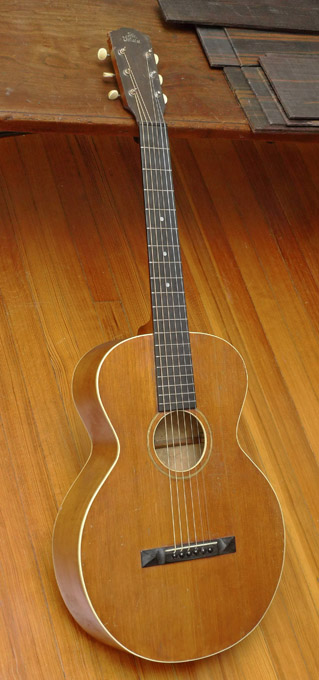 This historically significant Gibson L-1, 12-fret flat top guitar, is the earliest true Gibson flat top guitar on the market today. As well as the one in the best, original condition. And it is a rare example, exhibiting transitional features that place it just barely after the 1926 introduction– yet still a 1926 model (Factory order number: 8406)– but leaning toward a few subsequent, very early changes that would establish Gibson on the flat top scene that Martin had carved out so well. Introduced in '26 (there was already a L-1 archtop), the original Gibson L-1 flat top had a 13-1/2" body, wide V-neck, and H-bracing. The L-1 later achieved fame due to its association with the legendary bluesman Robert Johnson. Its rounded lower bout, combined with narrow waist, is distinctive. And its thin braces, thin finish, and thin woods give it a wonderful woody yet loud, cutting, bluesy tone that no 1930’s– much less more modern– Gibson or Martin could achieve. It is the transitional nature of this particular guitar, that is intriguing. The very first L-1 flat top, had an arched back (birch, or maple), and a pretty fat V-shaped neck. Other traits of the very first L-1 flat top: single bound top; maple back and sides; no truss rod; unbound ebony fingerboard; H pattern top bracing; “The Gibson” paint logo straight across peghead; light amber top finish; Sheraton brown finish on back and sides; single bound back. But this L-1, though very early, does not have arched back, but rather a true flat top-style back. And its neck is a great-playing C shape, not overly fat, and not a V shape. Furthermore, it has “A” bracing, not the standard H bracing. Finally, this guitar has a (original) ebony fretboard with virtually no radius. It’s a true “transition” example. It is notably not a hybrid put together from old L-1 archtop parts– as were the very first L-1 “flat tops” out of the gate in 1926. These are the traits of this early Gibson L-1 flat top:
This historically significant Gibson L-1, 12-fret flat top guitar, is the earliest true Gibson flat top guitar on the market today. As well as the one in the best, original condition. And it is a rare example, exhibiting transitional features that place it just barely after the 1926 introduction– yet still a 1926 model (Factory order number: 8406)– but leaning toward a few subsequent, very early changes that would establish Gibson on the flat top scene that Martin had carved out so well. Introduced in '26 (there was already a L-1 archtop), the original Gibson L-1 flat top had a 13-1/2" body, wide V-neck, and H-bracing. The L-1 later achieved fame due to its association with the legendary bluesman Robert Johnson. Its rounded lower bout, combined with narrow waist, is distinctive. And its thin braces, thin finish, and thin woods give it a wonderful woody yet loud, cutting, bluesy tone that no 1930’s– much less more modern– Gibson or Martin could achieve. It is the transitional nature of this particular guitar, that is intriguing. The very first L-1 flat top, had an arched back (birch, or maple), and a pretty fat V-shaped neck. Other traits of the very first L-1 flat top: single bound top; maple back and sides; no truss rod; unbound ebony fingerboard; H pattern top bracing; “The Gibson” paint logo straight across peghead; light amber top finish; Sheraton brown finish on back and sides; single bound back. But this L-1, though very early, does not have arched back, but rather a true flat top-style back. And its neck is a great-playing C shape, not overly fat, and not a V shape. Furthermore, it has “A” bracing, not the standard H bracing. Finally, this guitar has a (original) ebony fretboard with virtually no radius. It’s a true “transition” example. It is notably not a hybrid put together from old L-1 archtop parts– as were the very first L-1 “flat tops” out of the gate in 1926. These are the traits of this early Gibson L-1 flat top:- Single bound, red spruce top, with amber stain
- Original ebony bridge; original cellulose bridge pins (unslotted)
- Maple back and sides (back is not arched), with Sheraton brown finish
- Mahogany neck, C-shaped
- Original, very thin maple bridge plate, tucked under braces, and extending all the way to the kerfing at the sides of the top, and tucked under the Kerfing
- No truss rod
- Unbound ebony fingerboard (not “ebonized”, but solid ebony)
- “The Gibson” paint logo straight across peghead
- Single bound (ivoroid) top
- Single bound (ivoroid) back
- H bracing (a slight variation of “A” bracing; with the apex at either side of the neck block– and the braces actually tuck beneath the neck block)
- Pearl dots on 5,7, and 9 frets
- Original three-on-a-plate tuners, with plastic tuner buttons
- Original frets
- Original ebony nut
- 13 5/8 inch, lower bout
- 24 1/2 inch scale (not the 25 inch scale that was soon settled on by Gibson for the L-1, soon after the introduction)
- Nut width: just shy of 1 7/8 inch
- Width of fretboard at 12th fret: 2 ¼ inch
- String spacing at nut: a hair over 1 ½ inch
- String spacing at bridge: 2 3/8 inch
- Three well-repaired top cracks (all, with the grain; and the amber finish on top is very forgiving, in terms of appearance, so cracks are hardly visible)
- One replaced tuner post
-
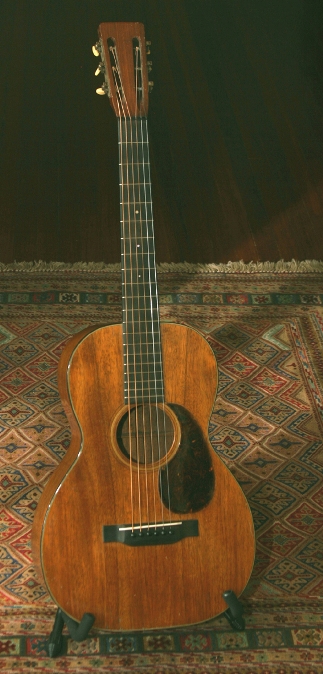 We converted this Golden Era 12-fret Koa Martin from the original Hawaiian setup ourselves, so it's perfect. The instrument does not have a crack anywhere. All original finish. Original Ebony bridge, converted from the tall Hawaiian set-up to a normal 30's set-up. Same with the ebony nut. All new, period-perfect Bar Frets. We radiused the ebony fretboard to 30's Martin specs. Neck was set and action is perfect. 1-7/8 inch nut width. Original tuners. Original bridge plate. Minor nicks and dings on top and back, but with the all original finish and crack-free, it's a rare specimen. Nothing compares in tone to an all-Koa Golden Age Martin. Koa blends the midrange of mahogany with the top end of maple-or, in the case of a fine 30's Koa Martin- hints of Brazilian rosewood. This fine 0-18K has all you would want from a Koa Martin, with the clearest, bell-like treble string tone imaginable.
We converted this Golden Era 12-fret Koa Martin from the original Hawaiian setup ourselves, so it's perfect. The instrument does not have a crack anywhere. All original finish. Original Ebony bridge, converted from the tall Hawaiian set-up to a normal 30's set-up. Same with the ebony nut. All new, period-perfect Bar Frets. We radiused the ebony fretboard to 30's Martin specs. Neck was set and action is perfect. 1-7/8 inch nut width. Original tuners. Original bridge plate. Minor nicks and dings on top and back, but with the all original finish and crack-free, it's a rare specimen. Nothing compares in tone to an all-Koa Golden Age Martin. Koa blends the midrange of mahogany with the top end of maple-or, in the case of a fine 30's Koa Martin- hints of Brazilian rosewood. This fine 0-18K has all you would want from a Koa Martin, with the clearest, bell-like treble string tone imaginable. -
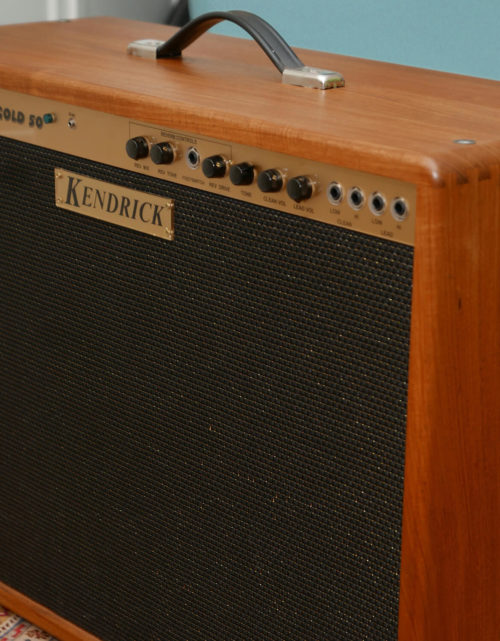 This was one of the best amps ever made by the legendary Gerald Weber. All-tube circuitry, designed and made in the USA, by Weber. It not only has power to spare (50 watts), but its unique circuitry has two channels, clean and lead, with different preamp circuit. These channels can be blended through patching the second input of one channel into the first input of the other, for purposes of blending the two channels together and further tone shaping with the interactive tone circuit. The bottom line: Tons of power if you need it, but the ability to get all the creamy, lush lead tones with the lead channel and/or blending. You just have to hear it. Original, handmade hardwood cabinet. 2 x 12: one 12 inch Kendrick brown frame and one 12 inch Kendrick black frame speaker. Kendrick's double spring reverb with three controls. Great condition. Recently serviced by one of the best amp techs in Texas. Price: $1495. No shipping. Local pickup only in Austin.
This was one of the best amps ever made by the legendary Gerald Weber. All-tube circuitry, designed and made in the USA, by Weber. It not only has power to spare (50 watts), but its unique circuitry has two channels, clean and lead, with different preamp circuit. These channels can be blended through patching the second input of one channel into the first input of the other, for purposes of blending the two channels together and further tone shaping with the interactive tone circuit. The bottom line: Tons of power if you need it, but the ability to get all the creamy, lush lead tones with the lead channel and/or blending. You just have to hear it. Original, handmade hardwood cabinet. 2 x 12: one 12 inch Kendrick brown frame and one 12 inch Kendrick black frame speaker. Kendrick's double spring reverb with three controls. Great condition. Recently serviced by one of the best amp techs in Texas. Price: $1495. No shipping. Local pickup only in Austin.